-
 Vase with Gladioli and Chinese Asters_Vincent Van Gogh
Vase with Gladioli and Chinese Asters_Vincent Van Gogh This is one of more than 35 flower still lifes that Van Gogh painted in Paris in the summer of 1886. He hoped that paintings of flowers would sell well. These were also exercises in the use of colour and a loose style of painting. In this still life, he worked with strong colour contrasts in complementary colours, placing green and red side by side, or blue and orange. Pairs like these form the basis of the colour theory of Eugène Delacroix (1798-1863), an artist Van Gogh greatly admired.
-
 "The Dinner Party---Primordial Goddess Plate"_Judy Chicago
"The Dinner Party---Primordial Goddess Plate"_Judy Chicago Judy Chicago’s original concept for The Dinner Party was multi-faceted in that her goal was to introduce the richness of women’s heritage into the culture in three ways; a monumental work of art, a book and a film because she had discovered so much unknown information.
-
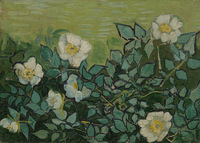 “Wild Roses"_Vincent Van Gogh
“Wild Roses"_Vincent Van Gogh This picture of wild roses may look very pleasant and peaceful, but Van Gogh was actually suffering a severe mental crisis at the time. He had entered the psychiatric clinic in Saint-Rémy-de-Provence as a voluntary patient, hoping to find peace there. As soon as he could, he went out into the gardens to paint or draw. Van Gogh has painted the fragile blossoms naturalistically. But he has treated the green leaves differently. He has turned them into flat areas of plain colour surrounded by heavy blue outlines.
-
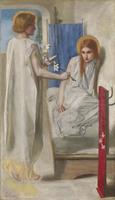 "Ecce Ancilla Domini" (The Annunciation)_Dante Gabriel Rossetti
"Ecce Ancilla Domini" (The Annunciation)_Dante Gabriel Rossetti Inspired by the work of early Renaissance artists such as Botticelli (1445-1510) and Fra Angelico (1387-1455), Rossetti sought in this work a radical reinterpretation of the Annunciation. Traditionally the Virgin was depicted in studious contemplation, reading a missal at a prie-dieu; but here Rossetti shows her rising awkwardly from a low bed, as if disturbed from sleep, while the Angel Gabriel presents her with a white lily. Both figures are dressed in white, a symbol of the virgin's purity, and the angel's role as the messenger of god is emphasised by the small white dove hovering beside him, signifying the presence of the holy spirit. Rossetti used several sitters for his figures, including his brother, William Michael, for the Angel and his sister, Christina, for the Virgin. A companion piece showing the Virgin's death was planned, but never begun. This partly explains the tall narrow shape of the picture, which was intended as part of a diptych. Rossetti intentionally restricted his palette almost entirely to white and the three primaries. The colour blue, symbolic of heaven, is traditionally associated with the Virgin and red symbolises the blood of Christ. Rossetti even sought a red-haired model for the Virgin's head. The composition is carefully thought out: the vertical division of space, made by the blue hanging and the edge of the bed, falls almost on the Golden Section. The dove and the lily, with one bud still to break, move across this division and are the instruments of conception. Rossetti has written the date, 'March', at the bottom of the canvas, perhaps to signify the month in which the Feast of the Annunciation is held. The original frame was also inscribed with Latin mottoes, copied from a brass rubbing owned by a fellow member of the Pre-Raphaelite Brotherhood, F.G. Stephens (1828-1907).
-
 "Autumn Sunshine"_George Cochran Lambdin
"Autumn Sunshine"_George Cochran Lambdin George Cochran Lambdin painted this work while living in Philadelphia's Germantown section,an area famed in the late nineteenth century for its gardens. Lambdin turned his attention to paintings of flowers in 1870, probably inspired by the English Pre-Raphaelites, who believed that a closer study of nature resulted in paintings that were more spiritually truthful. In Autumn Sunshine, Lambdin did not use the traditional composition of a vase of flowers on a tabletop. Instead, his painting of potted plants on the floor of a greenhouse captures the flowers as they are still growing, creating a more natural image. The soft tones of yellow and pink emphasize the delicate texture of the chrysanthemum's petals, while the dead leaves, together with the thin vine in the background, enhance the feeling of having captured a fleeting moment in nature.
-
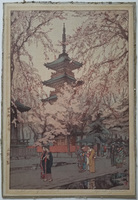 "A Glimpse of Ueno Park"_Yoshida Hiroshi
"A Glimpse of Ueno Park"_Yoshida Hiroshi Following the Great Kanto Earthquake of 1923, Hiroshi Yoshida embarked on a tour of the United States and Europe, painting and selling his work. When he returned to Japan in 1925, he started his own workshop, specializing in landscapes inspired both by his native country and his travels abroad. Yoshida often worked through the entire process himself: designing the print, carving his own blocks, and printing his work. His career was temporarily interrupted by his sojourn as a war correspondent in Manchuria during the Pacific War. Although he designed his last print in 1946, Yoshida continued to paint with oils and watercolors up until his death in 1950. Hiroshi Yoshida was widely traveled and knowledgeable of Western aesthetics, yet maintained an allegiance to traditional Japanese techniques and traditions. Attracted by the calmer moments of nature, his woodblock prints breathe coolness, invite meditation, and set a soft, peaceful mood. All of his lifetime prints are signed “Hiroshi Yoshida” in pencil and marked with a jizuri (self-printed) seal outside of the margin. Within the image, most prints are signed “Yoshida” with brush and ink beside a red “Hiroshi” seal.
-
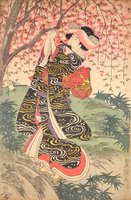 "Springtime"_Toyokuni ga
"Springtime"_Toyokuni ga Ukiyo-e artist Utagawa Toyokuni catapulted the eponymous Utagawa School to fame with his prints of elegant courtesans and actors, book illustrations, and paintings. He had a strong reputation during his lifetime and taught a host of talented students who carried on the traditions of the Utagawa School, including Utagawa Kunisada and Kuniyoshi. Toyokuni drew inspiration from the famous contemporary artists around him, particularly from Kitagawa Utamaro. During the early 1790s, his output mainly consisted of portraits of courtesans, who bear an elegance and idealism indicative of the period. These works set a standard for bijin-ga (pictures of beautiful women) for Ukiyo-e artists for generations to come. Through the 1790s and 1800s, Toyokuni not only captured actors’ stage roles, but also their private lives and individual personalities in his yakusha-e (actor prints).
-
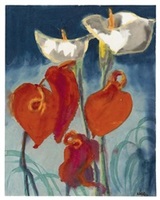 "Callas und Anthurien"_Emil Nolde
"Callas und Anthurien"_Emil Nolde A wood carver and draftsman, Emil Nolde studied arts and crafts early on and eventually took up painting and printmaking as a full time profession at the age of 31. His intensely colored, gestural oil paintings of urban nightlife, biblical scenes, flower motifs, and landscapes are considered among the best examples of German Expressionism and admired for their intense psychological power. Traces of Primitivism are evident in his incorporation of exotic figures and masks, especially in his later watercolors inspired by a journey to the South Pacific. Likewise, among Die Brücke, a group of German Expressionists with whom he was associated, Nolde was considered the preeminent intaglio printmaker. He achieved rich tonal effects and textural results with a unique treatment of the copper plate.
-
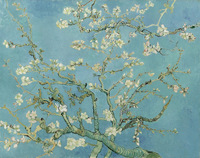 "Almond Blossom"_Vincent Van Gogh
"Almond Blossom"_Vincent Van Gogh Large blossom branches like this against a blue sky were one of Van Gogh’s favourite subjects. Almond trees flower early in the spring making them a symbol of new life. Van Gogh borrowed the subject, the bold outlines and the positioning of the tree in the picture plane from Japanese printmaking. The painting was a gift for his brother Theo and sister-in-law Jo, who had just had a baby son, Vincent Willem. In the letter announcing the new arrival, Theo wrote: ‘As we told you, we’ll name him after you, and I’m making the wish that he may be as determined and as courageous as you.’ Unsurprisingly, it was this work that remained closest to the hearts of the Van Gogh family. Vincent Willem went on to found the Van Gogh Museum.
-
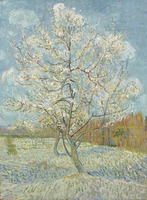 "The Pink Peach Tree"_Vincent Van Gogh
"The Pink Peach Tree"_Vincent Van Gogh Van Gogh painted many fruit orchards during his first weeks in Arles (FR). There is an earlier, nearly identical version of this painting, which Van Gogh had completed in one sitting. ‘I’d worked on a no. 20 canvas in the open air in an orchard — ploughed lilac field, a reed fence — two pink peach trees against a glorious blue and white sky. Probably the best landscape I’ve done’, he wrote. When he returned home, he saw the death notice of Anton Mauve (1838-1888), his uncle by marriage. Mauve was a well-known painter from whom Van Gogh had once taken lessons. He dedicated that first work to Mauve and made this new version later to send to Theo.
-
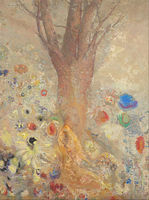 "The Buddha"_Odilon Redon
"The Buddha"_Odilon Redon The Buddha figure sits in the lotus position under a tree and almost seems part of it. Redon has achieved this effect by using little more than a few outlines to depict it. The artist was deeply interested in eastern spirituality. To give the picture a fresco-like appearance, Redon has chosen a particularly matt sort of paint. He intended the painting to be countersunk into a wall, making it an integral decorative feature of an interior.
-
 "Pandora"_Odilon Redon
"Pandora"_Odilon Redon symbolism (artistic concept)
 Vase with Gladioli and Chinese Asters_Vincent Van Gogh This is one of more than 35 flower still lifes that Van Gogh painted in Paris in the summer of 1886. He hoped that paintings of flowers would sell well. These were also exercises in the use of colour and a loose style of painting. In this still life, he worked with strong colour contrasts in complementary colours, placing green and red side by side, or blue and orange. Pairs like these form the basis of the colour theory of Eugène Delacroix (1798-1863), an artist Van Gogh greatly admired.
Vase with Gladioli and Chinese Asters_Vincent Van Gogh This is one of more than 35 flower still lifes that Van Gogh painted in Paris in the summer of 1886. He hoped that paintings of flowers would sell well. These were also exercises in the use of colour and a loose style of painting. In this still life, he worked with strong colour contrasts in complementary colours, placing green and red side by side, or blue and orange. Pairs like these form the basis of the colour theory of Eugène Delacroix (1798-1863), an artist Van Gogh greatly admired. "The Dinner Party---Primordial Goddess Plate"_Judy Chicago Judy Chicago’s original concept for The Dinner Party was multi-faceted in that her goal was to introduce the richness of women’s heritage into the culture in three ways; a monumental work of art, a book and a film because she had discovered so much unknown information.
"The Dinner Party---Primordial Goddess Plate"_Judy Chicago Judy Chicago’s original concept for The Dinner Party was multi-faceted in that her goal was to introduce the richness of women’s heritage into the culture in three ways; a monumental work of art, a book and a film because she had discovered so much unknown information. “Wild Roses"_Vincent Van Gogh This picture of wild roses may look very pleasant and peaceful, but Van Gogh was actually suffering a severe mental crisis at the time. He had entered the psychiatric clinic in Saint-Rémy-de-Provence as a voluntary patient, hoping to find peace there. As soon as he could, he went out into the gardens to paint or draw. Van Gogh has painted the fragile blossoms naturalistically. But he has treated the green leaves differently. He has turned them into flat areas of plain colour surrounded by heavy blue outlines.
“Wild Roses"_Vincent Van Gogh This picture of wild roses may look very pleasant and peaceful, but Van Gogh was actually suffering a severe mental crisis at the time. He had entered the psychiatric clinic in Saint-Rémy-de-Provence as a voluntary patient, hoping to find peace there. As soon as he could, he went out into the gardens to paint or draw. Van Gogh has painted the fragile blossoms naturalistically. But he has treated the green leaves differently. He has turned them into flat areas of plain colour surrounded by heavy blue outlines. "Ecce Ancilla Domini" (The Annunciation)_Dante Gabriel Rossetti Inspired by the work of early Renaissance artists such as Botticelli (1445-1510) and Fra Angelico (1387-1455), Rossetti sought in this work a radical reinterpretation of the Annunciation. Traditionally the Virgin was depicted in studious contemplation, reading a missal at a prie-dieu; but here Rossetti shows her rising awkwardly from a low bed, as if disturbed from sleep, while the Angel Gabriel presents her with a white lily. Both figures are dressed in white, a symbol of the virgin's purity, and the angel's role as the messenger of god is emphasised by the small white dove hovering beside him, signifying the presence of the holy spirit. Rossetti used several sitters for his figures, including his brother, William Michael, for the Angel and his sister, Christina, for the Virgin. A companion piece showing the Virgin's death was planned, but never begun. This partly explains the tall narrow shape of the picture, which was intended as part of a diptych. Rossetti intentionally restricted his palette almost entirely to white and the three primaries. The colour blue, symbolic of heaven, is traditionally associated with the Virgin and red symbolises the blood of Christ. Rossetti even sought a red-haired model for the Virgin's head. The composition is carefully thought out: the vertical division of space, made by the blue hanging and the edge of the bed, falls almost on the Golden Section. The dove and the lily, with one bud still to break, move across this division and are the instruments of conception. Rossetti has written the date, 'March', at the bottom of the canvas, perhaps to signify the month in which the Feast of the Annunciation is held. The original frame was also inscribed with Latin mottoes, copied from a brass rubbing owned by a fellow member of the Pre-Raphaelite Brotherhood, F.G. Stephens (1828-1907).
"Ecce Ancilla Domini" (The Annunciation)_Dante Gabriel Rossetti Inspired by the work of early Renaissance artists such as Botticelli (1445-1510) and Fra Angelico (1387-1455), Rossetti sought in this work a radical reinterpretation of the Annunciation. Traditionally the Virgin was depicted in studious contemplation, reading a missal at a prie-dieu; but here Rossetti shows her rising awkwardly from a low bed, as if disturbed from sleep, while the Angel Gabriel presents her with a white lily. Both figures are dressed in white, a symbol of the virgin's purity, and the angel's role as the messenger of god is emphasised by the small white dove hovering beside him, signifying the presence of the holy spirit. Rossetti used several sitters for his figures, including his brother, William Michael, for the Angel and his sister, Christina, for the Virgin. A companion piece showing the Virgin's death was planned, but never begun. This partly explains the tall narrow shape of the picture, which was intended as part of a diptych. Rossetti intentionally restricted his palette almost entirely to white and the three primaries. The colour blue, symbolic of heaven, is traditionally associated with the Virgin and red symbolises the blood of Christ. Rossetti even sought a red-haired model for the Virgin's head. The composition is carefully thought out: the vertical division of space, made by the blue hanging and the edge of the bed, falls almost on the Golden Section. The dove and the lily, with one bud still to break, move across this division and are the instruments of conception. Rossetti has written the date, 'March', at the bottom of the canvas, perhaps to signify the month in which the Feast of the Annunciation is held. The original frame was also inscribed with Latin mottoes, copied from a brass rubbing owned by a fellow member of the Pre-Raphaelite Brotherhood, F.G. Stephens (1828-1907). "Autumn Sunshine"_George Cochran Lambdin George Cochran Lambdin painted this work while living in Philadelphia's Germantown section,an area famed in the late nineteenth century for its gardens. Lambdin turned his attention to paintings of flowers in 1870, probably inspired by the English Pre-Raphaelites, who believed that a closer study of nature resulted in paintings that were more spiritually truthful. In Autumn Sunshine, Lambdin did not use the traditional composition of a vase of flowers on a tabletop. Instead, his painting of potted plants on the floor of a greenhouse captures the flowers as they are still growing, creating a more natural image. The soft tones of yellow and pink emphasize the delicate texture of the chrysanthemum's petals, while the dead leaves, together with the thin vine in the background, enhance the feeling of having captured a fleeting moment in nature.
"Autumn Sunshine"_George Cochran Lambdin George Cochran Lambdin painted this work while living in Philadelphia's Germantown section,an area famed in the late nineteenth century for its gardens. Lambdin turned his attention to paintings of flowers in 1870, probably inspired by the English Pre-Raphaelites, who believed that a closer study of nature resulted in paintings that were more spiritually truthful. In Autumn Sunshine, Lambdin did not use the traditional composition of a vase of flowers on a tabletop. Instead, his painting of potted plants on the floor of a greenhouse captures the flowers as they are still growing, creating a more natural image. The soft tones of yellow and pink emphasize the delicate texture of the chrysanthemum's petals, while the dead leaves, together with the thin vine in the background, enhance the feeling of having captured a fleeting moment in nature. "A Glimpse of Ueno Park"_Yoshida Hiroshi Following the Great Kanto Earthquake of 1923, Hiroshi Yoshida embarked on a tour of the United States and Europe, painting and selling his work. When he returned to Japan in 1925, he started his own workshop, specializing in landscapes inspired both by his native country and his travels abroad. Yoshida often worked through the entire process himself: designing the print, carving his own blocks, and printing his work. His career was temporarily interrupted by his sojourn as a war correspondent in Manchuria during the Pacific War. Although he designed his last print in 1946, Yoshida continued to paint with oils and watercolors up until his death in 1950. Hiroshi Yoshida was widely traveled and knowledgeable of Western aesthetics, yet maintained an allegiance to traditional Japanese techniques and traditions. Attracted by the calmer moments of nature, his woodblock prints breathe coolness, invite meditation, and set a soft, peaceful mood. All of his lifetime prints are signed “Hiroshi Yoshida” in pencil and marked with a jizuri (self-printed) seal outside of the margin. Within the image, most prints are signed “Yoshida” with brush and ink beside a red “Hiroshi” seal.
"A Glimpse of Ueno Park"_Yoshida Hiroshi Following the Great Kanto Earthquake of 1923, Hiroshi Yoshida embarked on a tour of the United States and Europe, painting and selling his work. When he returned to Japan in 1925, he started his own workshop, specializing in landscapes inspired both by his native country and his travels abroad. Yoshida often worked through the entire process himself: designing the print, carving his own blocks, and printing his work. His career was temporarily interrupted by his sojourn as a war correspondent in Manchuria during the Pacific War. Although he designed his last print in 1946, Yoshida continued to paint with oils and watercolors up until his death in 1950. Hiroshi Yoshida was widely traveled and knowledgeable of Western aesthetics, yet maintained an allegiance to traditional Japanese techniques and traditions. Attracted by the calmer moments of nature, his woodblock prints breathe coolness, invite meditation, and set a soft, peaceful mood. All of his lifetime prints are signed “Hiroshi Yoshida” in pencil and marked with a jizuri (self-printed) seal outside of the margin. Within the image, most prints are signed “Yoshida” with brush and ink beside a red “Hiroshi” seal. "Springtime"_Toyokuni ga Ukiyo-e artist Utagawa Toyokuni catapulted the eponymous Utagawa School to fame with his prints of elegant courtesans and actors, book illustrations, and paintings. He had a strong reputation during his lifetime and taught a host of talented students who carried on the traditions of the Utagawa School, including Utagawa Kunisada and Kuniyoshi. Toyokuni drew inspiration from the famous contemporary artists around him, particularly from Kitagawa Utamaro. During the early 1790s, his output mainly consisted of portraits of courtesans, who bear an elegance and idealism indicative of the period. These works set a standard for bijin-ga (pictures of beautiful women) for Ukiyo-e artists for generations to come. Through the 1790s and 1800s, Toyokuni not only captured actors’ stage roles, but also their private lives and individual personalities in his yakusha-e (actor prints).
"Springtime"_Toyokuni ga Ukiyo-e artist Utagawa Toyokuni catapulted the eponymous Utagawa School to fame with his prints of elegant courtesans and actors, book illustrations, and paintings. He had a strong reputation during his lifetime and taught a host of talented students who carried on the traditions of the Utagawa School, including Utagawa Kunisada and Kuniyoshi. Toyokuni drew inspiration from the famous contemporary artists around him, particularly from Kitagawa Utamaro. During the early 1790s, his output mainly consisted of portraits of courtesans, who bear an elegance and idealism indicative of the period. These works set a standard for bijin-ga (pictures of beautiful women) for Ukiyo-e artists for generations to come. Through the 1790s and 1800s, Toyokuni not only captured actors’ stage roles, but also their private lives and individual personalities in his yakusha-e (actor prints). "Callas und Anthurien"_Emil Nolde A wood carver and draftsman, Emil Nolde studied arts and crafts early on and eventually took up painting and printmaking as a full time profession at the age of 31. His intensely colored, gestural oil paintings of urban nightlife, biblical scenes, flower motifs, and landscapes are considered among the best examples of German Expressionism and admired for their intense psychological power. Traces of Primitivism are evident in his incorporation of exotic figures and masks, especially in his later watercolors inspired by a journey to the South Pacific. Likewise, among Die Brücke, a group of German Expressionists with whom he was associated, Nolde was considered the preeminent intaglio printmaker. He achieved rich tonal effects and textural results with a unique treatment of the copper plate.
"Callas und Anthurien"_Emil Nolde A wood carver and draftsman, Emil Nolde studied arts and crafts early on and eventually took up painting and printmaking as a full time profession at the age of 31. His intensely colored, gestural oil paintings of urban nightlife, biblical scenes, flower motifs, and landscapes are considered among the best examples of German Expressionism and admired for their intense psychological power. Traces of Primitivism are evident in his incorporation of exotic figures and masks, especially in his later watercolors inspired by a journey to the South Pacific. Likewise, among Die Brücke, a group of German Expressionists with whom he was associated, Nolde was considered the preeminent intaglio printmaker. He achieved rich tonal effects and textural results with a unique treatment of the copper plate. "Almond Blossom"_Vincent Van Gogh Large blossom branches like this against a blue sky were one of Van Gogh’s favourite subjects. Almond trees flower early in the spring making them a symbol of new life. Van Gogh borrowed the subject, the bold outlines and the positioning of the tree in the picture plane from Japanese printmaking. The painting was a gift for his brother Theo and sister-in-law Jo, who had just had a baby son, Vincent Willem. In the letter announcing the new arrival, Theo wrote: ‘As we told you, we’ll name him after you, and I’m making the wish that he may be as determined and as courageous as you.’ Unsurprisingly, it was this work that remained closest to the hearts of the Van Gogh family. Vincent Willem went on to found the Van Gogh Museum.
"Almond Blossom"_Vincent Van Gogh Large blossom branches like this against a blue sky were one of Van Gogh’s favourite subjects. Almond trees flower early in the spring making them a symbol of new life. Van Gogh borrowed the subject, the bold outlines and the positioning of the tree in the picture plane from Japanese printmaking. The painting was a gift for his brother Theo and sister-in-law Jo, who had just had a baby son, Vincent Willem. In the letter announcing the new arrival, Theo wrote: ‘As we told you, we’ll name him after you, and I’m making the wish that he may be as determined and as courageous as you.’ Unsurprisingly, it was this work that remained closest to the hearts of the Van Gogh family. Vincent Willem went on to found the Van Gogh Museum. "The Pink Peach Tree"_Vincent Van Gogh Van Gogh painted many fruit orchards during his first weeks in Arles (FR). There is an earlier, nearly identical version of this painting, which Van Gogh had completed in one sitting. ‘I’d worked on a no. 20 canvas in the open air in an orchard — ploughed lilac field, a reed fence — two pink peach trees against a glorious blue and white sky. Probably the best landscape I’ve done’, he wrote. When he returned home, he saw the death notice of Anton Mauve (1838-1888), his uncle by marriage. Mauve was a well-known painter from whom Van Gogh had once taken lessons. He dedicated that first work to Mauve and made this new version later to send to Theo.
"The Pink Peach Tree"_Vincent Van Gogh Van Gogh painted many fruit orchards during his first weeks in Arles (FR). There is an earlier, nearly identical version of this painting, which Van Gogh had completed in one sitting. ‘I’d worked on a no. 20 canvas in the open air in an orchard — ploughed lilac field, a reed fence — two pink peach trees against a glorious blue and white sky. Probably the best landscape I’ve done’, he wrote. When he returned home, he saw the death notice of Anton Mauve (1838-1888), his uncle by marriage. Mauve was a well-known painter from whom Van Gogh had once taken lessons. He dedicated that first work to Mauve and made this new version later to send to Theo. "The Buddha"_Odilon Redon The Buddha figure sits in the lotus position under a tree and almost seems part of it. Redon has achieved this effect by using little more than a few outlines to depict it. The artist was deeply interested in eastern spirituality. To give the picture a fresco-like appearance, Redon has chosen a particularly matt sort of paint. He intended the painting to be countersunk into a wall, making it an integral decorative feature of an interior.
"The Buddha"_Odilon Redon The Buddha figure sits in the lotus position under a tree and almost seems part of it. Redon has achieved this effect by using little more than a few outlines to depict it. The artist was deeply interested in eastern spirituality. To give the picture a fresco-like appearance, Redon has chosen a particularly matt sort of paint. He intended the painting to be countersunk into a wall, making it an integral decorative feature of an interior. "Pandora"_Odilon Redon symbolism (artistic concept)
"Pandora"_Odilon Redon symbolism (artistic concept)